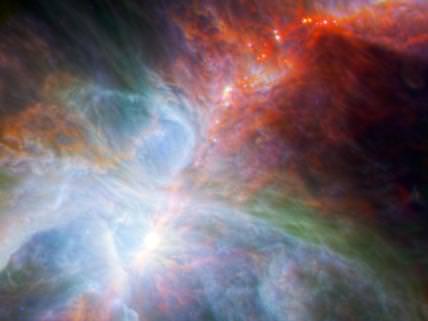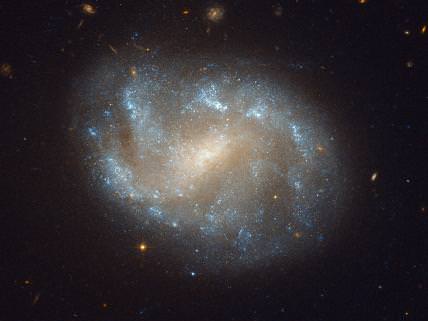←
SPACE WATCH
Orion’s Rainbow of Infrared Light NASA – This new view of the Orion Nebula highlights fledgling stars hidden in the gas and clouds. It shows infrared observations taken by NASA’s Spitzer Space Telescope and the European Space Agency‘s Herschel mission, in which NASA plays an important role.
NASA – This new view of the Orion Nebula highlights fledgling stars hidden in the gas and clouds. It shows infrared observations taken by NASA’s Spitzer Space Telescope and the European Space Agency‘s Herschel mission, in which NASA plays an important role.
Stars form as clumps of this gas and dust collapses, creating warm globs of material fed by an encircling disk. These dusty envelopes glow brightest at longer wavelengths, appearing as red dots in this image. In several hundred thousand years, some of the forming stars will accrete enough material to trigger nuclear fusion at their cores and then blaze into stardom.
Spitzer is designed to see shorter infrared wavelengths than Herschel. By combining their observations, astronomers get a more complete picture of star formation. The colors in this image relate to the different wavelengths of light, and to the temperature of material, mostly dust, in this region of Orion. Data from Spitzer show warmer objects in blue, with progressively cooler dust appearing green and red in the Herschel datasets. The more evolved, hotter embryonic stars thus appear in blue.
Infrared data at wavelengths of 8.0 and 24 microns from Spitzer are rendered in blue. Herschel data with wavelengths of 70 and 160 microns are represented in green and red, respectively.
This image was released on Feb. 29, 2012. Image Credit: NASA/ESA/JPL-Caltech/IRAM
Hubble Image of Galaxies’ El Dorado NASA’s Hubble Space Telescope has produced this beautiful image of the galaxy NGC 1483. NGC 1483 is a barred spiral galaxy located in the southern constellation of Dorado — the dolphinfish (or Mahi-mahi fish) in Spanish. The nebulous galaxy features a bright central bulge and diffuse arms with distinct star-forming regions. In the background, many other distant galaxies can be seen.
NASA’s Hubble Space Telescope has produced this beautiful image of the galaxy NGC 1483. NGC 1483 is a barred spiral galaxy located in the southern constellation of Dorado — the dolphinfish (or Mahi-mahi fish) in Spanish. The nebulous galaxy features a bright central bulge and diffuse arms with distinct star-forming regions. In the background, many other distant galaxies can be seen.
The constellation Dorado is home to the Dorado Group of galaxies, a loose group comprised of an estimated 70 galaxies and located some 62 million light-years away. The Dorado group is much larger than the Local Group that includes the Milky Way (and which contains around 30 galaxies) and approaches the size of a galaxy cluster. Galaxy clusters are the largest groupings of galaxies (and indeed the largest structures of any type) in the universe to be held together by their gravity.
Barred spiral galaxies are so named because of the prominent bar-shaped structures found in their center. They form about two thirds of all spiral galaxies, including the Milky Way. Recent studies suggest that bars may be a common stage in the formation of spiral galaxies, and may indicate that a galaxy has reached full maturity. Image Credit: ESA/Hubble & NASA
Related articles
- Galactic Views (28) (theneteconomy.wordpress.com)
- Galactic Views (27) (theneteconomy.wordpress.com)
- Galactic Views (26) (theneteconomy.wordpress.com)
- Galactic Views (16) (theneteconomy.wordpress.com)
- Galactic Views (17) (theneteconomy.wordpress.com)
Source: the Net economy